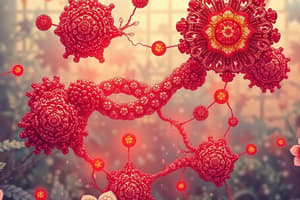Podcast
Questions and Answers
What is a catalyst?
What is a catalyst?
A substance that increases the rate of a chemical reaction by reducing the amount of energy needed to start the reaction.
What is an enzyme?
What is an enzyme?
An organic catalyst that catalyzes (helps) reactions in living organisms.
What is the active site and what is its job?
What is the active site and what is its job?
A specially-shaped area of the enzyme that fits around the substrate. It is where the enzyme grabs onto the substrate.
What is a substrate?
What is a substrate?
What is a product?
What is a product?
Explain how an enzyme works using the terms from 1-5.
Explain how an enzyme works using the terms from 1-5.
What is denaturing and what causes it to occur?
What is denaturing and what causes it to occur?
What 4 things can affect the way enzymes work? List them.
What 4 things can affect the way enzymes work? List them.
How can a lock and key be used to describe an enzyme?
How can a lock and key be used to describe an enzyme?
Why do enzymes generally only bind to one type of substrate?
Why do enzymes generally only bind to one type of substrate?
Explain how enzymes work using activation energy and compare curves.
Explain how enzymes work using activation energy and compare curves.
How does temperature affect enzyme activity? Use the word denature.
How does temperature affect enzyme activity? Use the word denature.
Using graph 3, explain how pH affects activity.
Using graph 3, explain how pH affects activity.
Flashcards
What are catalysts?
What are catalysts?
Catalysts are substances that speed up chemical reactions without being consumed in the process. They achieve this by lowering the activation energy – the minimum energy needed for the reaction to start.
What are enzymes?
What are enzymes?
Enzymes are biological catalysts, meaning they are proteins that speed up biochemical reactions in living organisms.
What is the active site of an enzyme?
What is the active site of an enzyme?
The active site is a specific, uniquely shaped region on an enzyme that binds to the substrate. This binding is essential for the enzyme's catalytic function.
What are substrates in enzyme reactions?
What are substrates in enzyme reactions?
Signup and view all the flashcards
How do enzymes work?
How do enzymes work?
Signup and view all the flashcards
What is enzyme denaturation?
What is enzyme denaturation?
Signup and view all the flashcards
What factors influence enzyme activity?
What factors influence enzyme activity?
Signup and view all the flashcards
What are activators in enzymatic reactions?
What are activators in enzymatic reactions?
Signup and view all the flashcards
What are inhibitors in enzymatic reactions?
What are inhibitors in enzymatic reactions?
Signup and view all the flashcards
Explain the Lock and Key model of enzyme action.
Explain the Lock and Key model of enzyme action.
Signup and view all the flashcards
Why are enzymes specific?
Why are enzymes specific?
Signup and view all the flashcards
How do enzymes affect reaction rates?
How do enzymes affect reaction rates?
Signup and view all the flashcards
How does temperature affect enzyme activity?
How does temperature affect enzyme activity?
Signup and view all the flashcards
Study Notes
Catalysts and Enzymes
- Catalysts increase chemical reaction rates by lowering activation energy.
- Enzymes are organic catalysts that facilitate biochemical reactions in living organisms.
Active Site and Substrate
- The active site is a uniquely shaped region of the enzyme that binds to the substrate.
- Substrates are the biological molecules upon which enzymes act.
Enzyme Function
- Enzymes bind to substrates at the active site, enabling a chemical reaction (catalysis) to occur.
- After the reaction, the enzyme releases the transformed substrate, now referred to as the product, and can catalyze additional reactions.
Denaturation
- Denaturation occurs when an enzyme's shape is altered, often due to changes in temperature, pH, or the presence of poisons.
- This alteration can prevent the enzyme from functioning effectively.
Factors Affecting Enzyme Activity
- Temperature changes can alter enzyme shape and function, affecting reaction rates.
- Activators enhance enzyme activity, allowing better binding to substrates.
- pH levels impact protein structure; extreme pH conditions can cause denaturation.
- Inhibitors can reduce enzyme activity: competitive inhibitors block the active site, while allosteric inhibitors modify the enzyme's shape.
Lock and Key Model
- Enzymes can be described using the lock and key analogy, where each enzyme is a specific lock and each substrate is a unique key, emphasizing their specificity in catalysis.
Specificity of Enzymes
- Enzymes typically bind to only one type of substrate, due to their specialized functions.
Activation Energy and Reaction Rates
- Enzymes lower the activation energy of reactions, leading to faster reaction rates compared to uncatalyzed processes.
Temperature Effects on Enzyme Activity
- Increasing temperature usually accelerates reactions, while extreme heat can denature enzymes, halting their activity.
pH and Enzyme Activity
- Each enzyme has an optimal pH range that supports its activity; deviations from this range can slow down functioning and impact overall reaction rates.
Studying That Suits You
Use AI to generate personalized quizzes and flashcards to suit your learning preferences.





